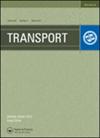SPATIAL PARTITION FOR HETEROGENEOUS CITY NETWORKS COMPOSED OF FACTORS THAT INFLUENCE THE DISTRIBUTION OF THE MACROSCOPIC FUNDAMENTAL DIAGRAM
IF 1.3
4区 工程技术
Q3 TRANSPORTATION SCIENCE & TECHNOLOGY
引用次数: 0
Abstract
Using a Macroscopic Fundamental Diagram (MFD) to implement partition control is effective in improving mobility in heterogeneous city networks. As one of the most complex issues in partition control, accurate sub-region partition is critical for control effectiveness. Current partition methods focus on the link density and precondition of existing MFD and disregard the factors that influence MFD distribution. To overcome this drawback, this study uses the characteristic value of the link and the intersection connected to the link as the analysis object and proposes an MFD sub-region partitioning method for large-scale networks. Firstly, the influences of road state parameters on MFD distribution are classified into traffic flow parameters, network physical properties, network operation mechanisms and emergencies. Simulation experiments are conducted to determine the degree to which these classifications affect MFD distribution. Secondly, a partition method combined with the link density and influence parameters of MFD is developed. The method is used for a preliminarily division of a road network through Minimum Spanning Tree (MST) and depth partition by the Normalised Cut (Ncut) algorithm. Finally, a case study is conducted in an actual city centre network, and results show that the developed method is superior to the single method based simply on link density.由影响宏观基本图分布的因素组成的异质城市网络的空间分区
使用宏观基本图(MFD)实施分区控制可有效改善异构城市网络的移动性。作为分区控制中最复杂的问题之一,精确的子区域划分对控制效果至关重要。目前的分区方法主要关注现有 MFD 的链路密度和前提条件,而忽略了影响 MFD 分布的因素。为克服这一缺陷,本研究以链路及与链路相连的交叉口的特征值为分析对象,提出了一种大规模网络的 MFD 子区域划分方法。首先,将道路状态参数对 MFD 分布的影响分为交通流参数、网络物理特性、网络运行机制和突发事件。通过仿真实验确定这些分类对 MFD 分布的影响程度。其次,结合 MFD 的链路密度和影响参数,开发了一种分区方法。该方法通过最小生成树(MST)对道路网络进行初步划分,并通过归一化切割(Ncut)算法进行深度划分。最后,在实际的市中心网络中进行了案例研究,结果表明所开发的方法优于单纯基于链接密度的单一方法。
本文章由计算机程序翻译,如有差异,请以英文原文为准。
求助全文
约1分钟内获得全文
求助全文
来源期刊

Transport
Engineering-Mechanical Engineering
CiteScore
3.40
自引率
5.90%
发文量
19
审稿时长
4 months
期刊介绍:
At present, transport is one of the key branches playing a crucial role in the development of economy. Reliable and properly organized transport services are required for a professional performance of industry, construction and agriculture. The public mood and efficiency of work also largely depend on the valuable functions of a carefully chosen transport system. A steady increase in transportation is accompanied by growing demands for a higher quality of transport services and optimum efficiency of transport performance. Currently, joint efforts taken by the transport experts and governing institutions of the country are required to develop and enhance the performance of the national transport system conducting theoretical and empirical research.
TRANSPORT is an international peer-reviewed journal covering main aspects of transport and providing a source of information for the engineer and the applied scientist.
The journal TRANSPORT publishes articles in the fields of:
transport policy;
fundamentals of the transport system;
technology for carrying passengers and freight using road, railway, inland waterways, sea and air transport;
technology for multimodal transportation and logistics;
loading technology;
roads, railways;
airports, ports, transport terminals;
traffic safety and environment protection;
design, manufacture and exploitation of motor vehicles;
pipeline transport;
transport energetics;
fuels, lubricants and maintenance materials;
teamwork of customs and transport;
transport information technologies;
transport economics and management;
transport standards;
transport educology and history, etc.
 求助内容:
求助内容: 应助结果提醒方式:
应助结果提醒方式:


